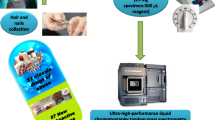Abstract
Measurement of drug concentrations in hair provides a non-invasive approach to assess drug adherence. Here, we report on the development and validation of a method for the quantification of the antiretroviral dolutegravir (DTG) extracted from human hair. DTG is extracted from hair samples by sonication and incubation in 50:50 methanol:acetonitrile with 2% formic acid overnight at 40 °C. Following extraction, samples are analyzed by reverse-phase chromatography on a Waters Atlantis T3 (50 × 2.1 mm, 3-μm particle size) column with subsequent detection by electrospray ionization in positive ion mode on an AB Sciex API-5000 triple quadrupole mass spectrometer. The stable, isotopically labeled 13C,d5-DTG is used as an internal standard in the assay. The calibration range is 5–10,000 pg DTG/mL of extraction solvent with the ability to extract between 1 and 10 mg of hair/mL of extraction solvent. The assay was linear, accurate (inter-assay %bias within ± 6.5%), and precise (inter-assay %CV ≤ 10.3%). The assay was successfully used to analyze clinical samples from subjects on DTG regimens. Analysis of clinical samples suggested the potential presence of a degradation product, which was subsequently confirmed to occur with exposure to sunlight. The degradation of DTG could complicate absolute interpretation of clinical results, but the presence of this degradation product is easily evaluated with this assay to aid in data interpretation.



Similar content being viewed by others
References
Castillo-Mancilla JR, Phillips AN, Neaton JD, Neuhaus J, Collins S, Mannheimer S, et al. Association of suboptimal antiretroviral therapy adherence with inflammation in virologically suppressed individuals enrolled in the SMART study. INSIGHT SMART Study Group. Open Forum Infect Dis. 2017;5(1):ofx275.
Panel on Antiretroviral Guidelines for Adults and Adolescents. Guidelines for the use of antiretroviral agents in adults and adolescents living with HIV. Department of Health and Human Services. Available at http://aidsinfo.nih.gov/contentfiles/lvguidelines/AdultandAdolescentGL.pdf.
Anderson PL, Liu AY, Castillo-Mancilla JR, Gardner EM, Seifert SM, McHugh C, et al. Intracellular tenofovir-diphosphate and emtricitabine-triphosphate in dried blood spots following directly observed therapy. Antimicrob Agents Chemother. 2017;62(1):e01710–7.
Podsadecki TJ, Vrijens BC, Tousset EP, Rode RA, Hanna GJ. “White coat compliance” limits the reliability of therapeutic drug monitoring in HIV-1-infected patients. HIV Clin Trials. 2008;9(4):238–46.
Castillo-Mancilla JR, Zheng JH, Rower JE, Meditz A, Gardner EM, Predhomme J, et al. Tenofovir, emtricitabine, and tenofovir diphosphate in dried blood spots for determining recent and cumulative drug exposure. AIDS Res Hum Retrovir. 2013;29(February (2)):384–90.
Schauer AP, Sykes C, Cottrell ML, Prince H, Kashuba ADM. Validation of an LC-MS/MS assay to simultaneously monitor the intracellular active metabolites of tenofovir, emtricitabine, and lamivudine in dried blood spots. J Pharm Biomed Anal. 2017;149:40–5.
Gandhi M, Ameli N, Bacchetti P, Anastos K, Gange SJ, Minkoff H, et al. Atazanavir concentration in hair is the strongest predictor of outcomes on antiretroviral therapy. Clin Infect Dis. 2011;52(10):1267–75.
van Zyl GU, van Mens TE, McIlleron H, Zeier M, Nachega JB, Decloedt E, et al. Low lopinavir plasma or hair concentrations explain second-line protease inhibitor failures in a resource-limited setting. J Acquir Immune Defic Syndr. 2011;56(4):333–9.
Gandhi M, Ameli N, Bacchetti P, Gange SJ, Anastos K, Levine A, et al. Protease inhibitor levels in hair strongly predict virologic response to treatment. AIDS. 2009;23(4):471–8.
Matuszewski. Standard line slopes as a measure of a relative matrix effect in quantitative HPLC-MS bioanalysis. J Chromatogr B Anal Technol Biomed Life Sci. 2006;830(January (2)):293–300.
LeBeau MA, Montgomery MA, Brewer JD. The role of variations in growth rate and sample collection on interpreting results of segmented analyses of hair. Forensic Sci Int. 2011;210(1–3):110–6.
Slawson MH, Wilkins DG, Rollins DE. The incorporation of drugs into hair: relationship of hair color and melanin concentration to phencyclidine incorporation. J Anal Toxicol. 1998;22(6):406–13.
Rollins DE, Wilkins DG, Krueger GG, Augsburger MP, Mizuno A, O’Neal C, et al. The effect of hair color on the incorporation of codeine into human hair. J Anal Toxicol. 2003;27(8):545–51.
Rothe M, Praqst F, Thor S, Hunger J. Effect of pigmentation on the drug deposition in hair of grey-haired subjects. Forensic Sci Int. 1997;84(1–3):53–60.
Hubbard DL, Wilkins DG, Rollins DE. The incorporation of cocaine and metabolites into hair: effects of dose and hair pigmentation. Drug Metab Dispos. 2000;28:1464–9.
Funding
This publication resulted from core activities of the University of North Carolina at Chapel Hill Center for AIDS Research (CFAR), an NIH-funded program (P30 AI50410), and the WIHS (Women’s Interagency HIV Study (U01 AI103390)). ADM Kashuba is also supported by R01 AI111891 and R01 AI122319.
Author information
Authors and Affiliations
Corresponding author
Ethics declarations
Conflict of interest
The authors declare that they have conflict of interest.
Rights and permissions
About this article
Cite this article
Sykes, C., Blake, K., White, N. et al. Development and validation of an LC-MS/MS assay for the quantification of dolutegravir extracted from human hair. Anal Bioanal Chem 410, 7773–7781 (2018). https://doi.org/10.1007/s00216-018-1394-y
Received:
Revised:
Accepted:
Published:
Issue Date:
DOI: https://doi.org/10.1007/s00216-018-1394-y




